We take a walk down Chatsworth Road and visit the businesses that have made the street so inviting over the years.
Chatsworth Road conjures memories of familiar buildings, traditional shops, family businesses and friendly faces.

Paper bag, printed with J Stoppard and Sons, 177 Chatsworth Road, Chesterfield, High Class Family Butchers. Established 1903. (2017.30)

An advert for W English and Son grocery shop, situated at 475a Chatsworth Road at the corner with Heaton Street. This shop opened in the mid1930s and closed in 1995.
It offered a personal service with a wide variety of products on sale from freshly ground coffee to washing powder. Mr English’s bacon was particularly famous for being the best money could buy and he’d cut it ‘as thick as you wanted’.

A film wallet from R E Wardell (1996.3065)
The Brampton Mile
Locally, Brampton is fondly remembered as a great place for a night out. Traditional pubs, each with their own unique character, surround Chatsworth Road. Holding countless memories of special occasions, celebrations or simply a lively evening out, they have brightened the lives of local residents all along the Brampton Mile.

Brampton Mile Map courtesy of Dirty Stop Outs. This fantastic illustration, from the Dirty Stop Out’s Guide to 1980s Chesterfield, shows a map of the Brampton Mile pub crawl. This challenging and infamous pursuit often defeated local revellers even before they reached the Town Centre.
The Brampton Mile included eighteen stops in all. Here are a few of those along the way…
Right at the start, furthest from the town centre, was the Terminus. Originally called The Old Pheasant, it was reopened as The Terminus in 1906. Sadly, the pub closed in 2000.
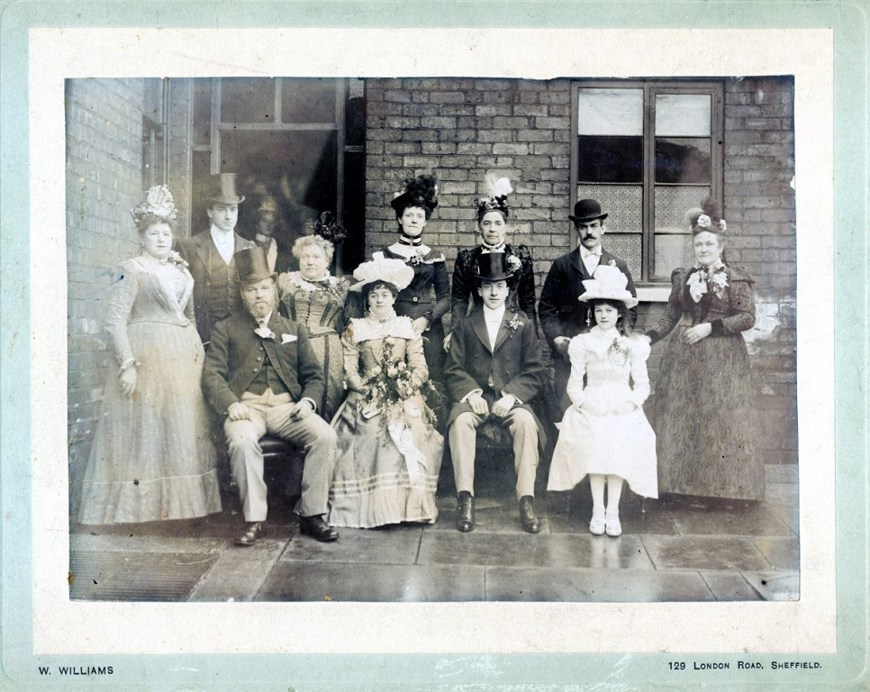
Here’s a cheery wedding party at the Three Horseshoes around 1900. Image courtesy of Chesterfield Local Studies Library. Acc.4564.
One of the oldest pubs on Chatsworth Road, the Three Horse Shoes opened in 1842. The licensee, Joseph Watts, was also the local blacksmith.
Even earlier, the Barrell Inn was in existence in 1822, when the area was known as Welshpool. The inn was bought by Brampton Brewery in 1899.
Almost at the town centre. The Bold Rodney was famous as the pub which hosted the Brampton Feast in the Yard just behind. It was transformed into disco pub Ziggy’s in 1987.
Brampton Breweries
Although a brewery had been in operation on Chatsworth Road since 1839, the name Brampton Brewery was only officially adopted in 1889.
When a fire significantly damaged the original building in 1902, like a phoenix from the flames, the brewery developed and extended a new building on the same site in 1905.
Fifty years later Brampton Brewery was sold. After a number of different owners the building was eventually demolished in the 1980s.
A new Brampton Brewery – inspired by the first - was founded in 2007. It now owns two local Brampton pubs; The Rose and Crown, Old Road and the Tramway Tavern, Chatsworth Road.
The trademark of Brampton Brewery is an arm holding a brick hammer. This stained glass detail can be seen at The Barrell Inn, Chatsworth Road.
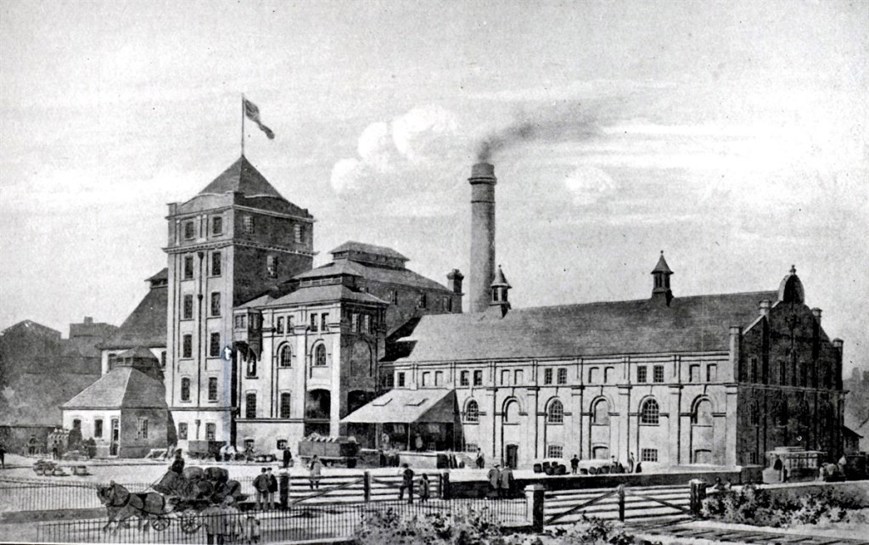
The new Brampton Brewery buildings in 1905.

Brampton Brewery bottle labels, 1950s.
Brampton community
Brampton has always been a vibrant area with a strong sense of community and plenty of opportunities for fun, exercise and entertainment.
Let’s take a look at some of the places where locals could escape the mundane and enjoy themselves as well as attending centres of recreation and faith.
Bradbury Hall began its history as Field House (an inn and brewery) before being rented by William Bradbury Robinson as a family home in the 1850s. In 1928, it was purchased by the Robinson company and extended. It provided a complex of facilities; a much needed canteen for the company’s growing workforce as well as a thriving social centre. It was also a popular venue for dances, amateur theatricals, and local events.
Bradbury Hall closed its doors in 1984. It was then bought and converted into a bar, but was always known as ‘The Brad’.

Programme for ''Wild Violets'' a musical comedy by Robinson and Sons Ltd Amateur Operatic Society, March 1954. Performed at Bradbury Hall. (1996.164)
Originally the Mount Zion Methodist Chapel, Brampton Coliseum Picture Palace was converted into a cinema in 1907and re-named Brampton Coliseum Picture Palace in 1916. Although surviving a fire in 1939, it couldn’t survive strong competition from other local cinemas. The Coliseum was forced to close in 1957. Its elegant last showing - High Society.
Walton Dam was built in the 18th century to provide a water supply for Walton Manor Corn Mill. The site was bought by Robinson’s in 1899, as a source of water for their cotton wool production. Later it provided an area for sporting and leisure activities for staff. Chesterfield Swimming Club also held events there.

The opening times for Markham Baths.
Markham Baths, an outdoor swimming pool on Chatsworth Road, was a gift to the town from Charles Paxton Markham, of Markham and Co Engineering. It was opened in 1915 and was in use until the mid-1970s.
St Thomas’ has always and continues to be a community focused church, providing a wide range of services and activities for local people.
St Thomas’ foundation stone was laid by William Spencer, 6th Duke of Devonshire in the 1830s. Almost a century later, in 1921, the 9th Duke of Devonshire would unveil the granite war memorial to 210 Brampton men who gave their lives during the Great War.
Built by William Bradbury Robinson in 1873, the Congregational Church offered numerous educational classes as well as support for new mothers.
After being demolished in 1969 the church’s war memorial was moved to Rose Hill. The church’s Sunday School frequently had an attendance of over 100 children.
Brampton: home of Robinsons of Chesterfield.
In 1839 chemist John Bradbury Robinson bought a round box business and set up production at Wheatbridge House, just by Chatsworth Road, Brampton.
Robinsons went on to produce boxes for medical supplies and dressings, as well as manufacturing all kinds of cardboard packaging.
The company went from strength to strength. A century after it was founded, Robinsons would employ over 4,000 people and was enormously significant in the lives of the local community.
Conflicts like the Crimean War (1854-56), the Boer War (1899-1902) and later World War 1 (1914-1918) saw demand grow for better medical products to dress wounds. Robinsons met this demand with innovation, developing lint and antiseptic dressings, sterilised bandages and cotton wool.
In the twentieth century, Robinsons’ resourcefulness would also lead to the large scale production of the first disposable sanitary towels and the advent of disposable nappies (Paddie-Pads) produced at the Griffin Mill site.

A Robinsons advert.
Robinsons made both round and square boxed packaging. One of their most famous designs was the iconic Smartie tube.

A meeting of managers and staff at Robinsons, circa 1910. (2002.5392)
In Brampton, Robinsons is still fondly remembered for the way it devoted itself to the welfare of its employees. Robinsons had regular management and employee meetings, paid holidays, housing and pension schemes and subsidised meals long before it was required or recommended by law.
In 1918 Robinsons opened its Preparatory School, School Board Lane, training young women to work in the factories but also teaching them about health, safety and personal hygiene. Local women were the driving force behind Robinsons success and, for generations, would be known as Robo’s Angels.
On 14 July 1939, to celebrate the company’s centenary, Robinsons organised a trip of a lifetime for 3700 employees to enjoy a day of sight-seeing in London and a Grand Variety Concert at the Albert Hall. For many, it was their first time outside of Chesterfield and an unforgettable experience.
Brampton Ware
In the eighteenth and nineteenth centuries, Brampton rapidly developed as a significant area producing saltglaze pottery.
The clay type needed to produce saltglaze was available locally, as was a ready supply of coal from the Brampton collieries. So successful was this type of pottery in the locality, that the term Brampton Ware would forever be linked with saltglaze ceramics.
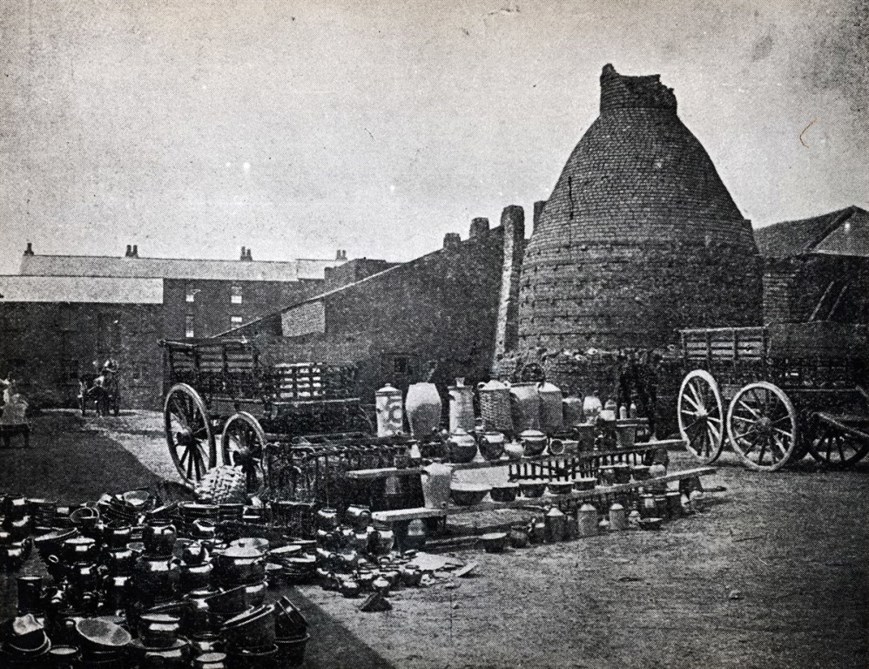
The Alma and Brunswick potteries were established by Samuel Lowe and Sons in 1854 and produced a wide variety of functional saltglaze ware as well as water filters. (1992.301)
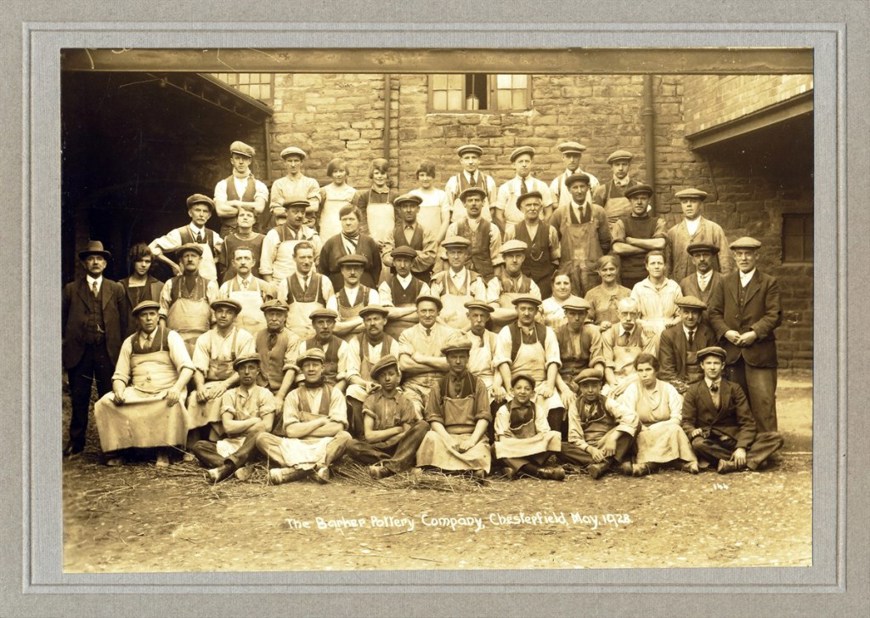
Barker Pottery Co. 1928. Courtesy of Mrs Sylvia Warburton.
Barker Pottery was founded around 1800 by Samuel and Henry Briddon and continued to operate under the Briddon family until 1957. The image above shows staff members from the pottery in 1920. In the centre stands Mr William Mason the site manager. This photograph was recently donated by his granddaughter, Sylvia.
Barker Pottery was founded around 1800 by Samuel and Henry Briddon and continued to operate under the Briddon family until 1957.

Artwork for James Pearson Ltd catalogue showing a stoneware jar. (1991.1393)
Oldfield Pottery was originally founded by a partnership of potters - Oldfield, Madin, Blake, Wright and Hewitt - in 1810 and by 1838 the nephew of one of the founders, John Oldfield, had greatly expanded the business.
Towards the end of the century, the works were purchased by James Pearson (twice Mayor of Chesterfield), who had decided to set up on his own, leaving Pearson Pottery in the Whittington Moor, North Chesterfield. The companies would merge once again in the 1930s.
One of the oldest works in Brampton is thought to have been the Welshpool Potteries, founded in the late 1700s. Under the management of Mr Knowles and Son, Welshpool Potteries focused on the production of stone ware bottles for ginger beer and jars for the delivery of ale and stout.
Brampton Works
Brampton was central to making Chesterfield a centre of manufacturing and engineering in the eighteenth, nineteenth and twentieth centuries.
Founded on the industrialisation of a once rural area to the west of Chesterfield, (New) Brampton saw its beginnings in the community of working people that grew around Chatsworth Road and the opportunities of work it offered.

Painting of Brampton and West Bars, based on a photograph taken in 1908 from the top of the Wheatbridge Works’ tower. In the foreground are the kilns of Wright’s Pottery and the Brampton Branch Line running along the River Hipper.
John Smith and partners established their business in Brampton close to the River Hipper in 1775.
After fifty years dominating Brampton industry, John and Ebenezer Smith and Co ceased to operate in 1833.
The Chesterfield Gas and Water Company started to produce gas on Foljambe Road in 1826 and would go on to provide gas for Chesterfield for well over one hundred years. The site was redeveloped in the 1990s.
Further along Chatsworth Road, the Plowright family took over Sneath’s iron and brass foundry in Shepley Street, in 1878.
Two of the Plowright brothers, Robert and William, spent time in Russia, establishing an engineering business before returning to Chesterfield.
By the turn of the century the Plowright’s mechanical engineering skills were well known to local colliery owners, who used the company for all urgent repairs. Plowright’s reputation as pioneers and modernisers of colliery engineering grew over the next decades, not only in Britain but worldwide. Financial difficulties saw Plowright’s close in 1963.
Brampton transport
By the 1860s, industries and communities all over Britain were eager to have access to better transport networks and Brampton was no different. In 1870, an Act of Parliament was passed to enable towns to build and manage their own railways and tramways. Locally, rail was for freight but trams were for people, providing efficient public transport that enabled a growing population to get around town.
The Brampton Branch Line at Boythorpe Road was originally completed in 1873. It linked with the Midland Railway and provided rail access to Brampton Colliery, the Gasworks, Robinsons and some of the Brampton potteries.
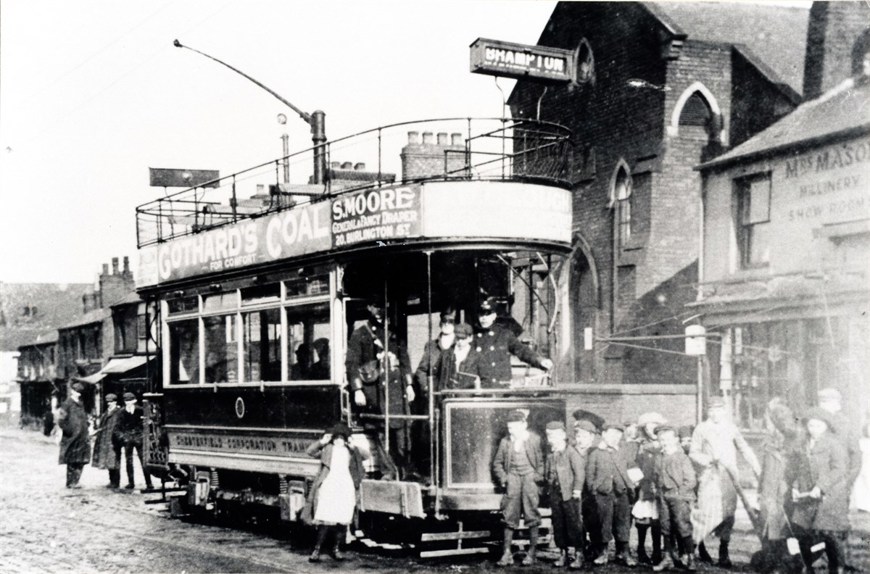
Brampton Tram outside Chapel 1997.332
The Chesterfield and District Tramway Company was founded in 1879 and commenced horse tram services in 1882.
In Chesterfield, the electric tramway network was established in 1904, running from the centre, north to Whittington Moor and west to Brampton.
In Brampton, the new depot and tram shed were situated on Chatsworth Road. The tramway was so popular that by 1914 the fleet had been extended to 17 trams.
By mid-1915, due to the number of men serving in WW1, women were being recruited as conductresses and by 1916 were also driving trams.
Due to high running costs, frequent and major renewals to tram track, by the mid-1920s other forms of transport were developed. In 1927 trams were replaced by the electric trolley bus service which continued to use the overhead power lines but no longer required tracks.
S Johnson and Son, Chatsworth Road.
In 2017, after almost 130 years serving the local community, a Chatsworth Road institution closed its doors.
Samuel Johnson – a tinsmith and brazier – opened S Johnson and Son with his son, Edward Palmer Johnson in 1888. They sold all kinds of tin goods, earning them the nickname “Tinny Johnson’s”.
The Johnson Family moved to 298 Chatsworth Road in the late 1890s, providing a general ironmongery service as well as continuing tin-smithing in the warehouse behind the shop. During WW1 Johnson and Son expanded its business, producing tin linings for the wooden boxes which held the Robinsons’ sterilised dressings sent to the Front Lines.
Under the management of Edward’s son, Teddy, and later his grandson, Philip, Johnson’s moved with the times. They undertook radio sales and repairs and sold all kinds of domestic appliances. The business also continued to remain very much a traditional ironmonger’s, offering everything from mousetraps to lawnmowers.

Advert for Sunrise Washing Machine, circa 1914. (Johnson Collection)

S Johnson and Son at 298 Chatsworth Road. Edward Palmer Johnson stands in the doorway and Samuel is on the right wearing the hat. The corn store on the left was also rented by the Johnsons in subsequent years.